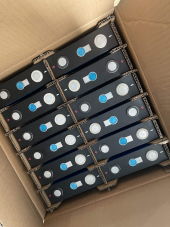SlimyLemur56
New Member
- Joined
- Feb 20, 2020
- Messages
- 27
My cells came with mincy M4 screws holes, 50% wouldn't accept the provided screws, and several stripped out just trying to get the screws to go in the very first time to test the threads. I retapped them to M8, using a drill press to start the tap in an attempt to keep it as square as possible. I am able to get M8 studs threaded in to almost the full depth of the original screws, but there is some slop and wiggle between the stud and the tapped hole because aluminum terminals were so gummy that the tap kept getting stuck, probably removing more material than it should.
Because of the slop, and the fact that unscrewing stud nuts could just unscrew the stud from the terminal, I want to epoxy the studs into the terminals. I have seen a lot of discussion about this but it seems to mostly gloss over what worries me the most, which is protecting the tops of the terminals from excess epoxy. I'm sortof looking for a sanity check about my paranoia about this, and any advice on techniques.
From what discussion I've read they seem to just say "clean the studs with acetone". Is it really so simple? I imagine a solvent just thinning the epoxy down until it's invisible but creating an invisible laminant reducing the conductivity. Is this an issue?
What I am planning to use currently is J-B Weld KwikWeld "Quick Settling Steel Reinforced Epoxy"
Would it be a good idea to do multiple wipes with fresh paper towels, a process for each terminal like:
1. get mixed epoxy in the holes and on the stud threads and insert them
2. dry wipe excess epoxy with a paper towel
3. solvent on a paper towel and rewipe, with the paper towel around the stud twisting like I was screwing the paper towel down on the stud against the terminal
4. new paper towel, new solvent, repeat #3 several times
Is there any chance of the epoxy offgassing some vapor as it cures/drys and depositing insulating material on the surrounding terminals the way superglue would? I know it's totally different than superglue but I don't know if something similar might happen
Am I making too big of a deal of the concern?
Is acetone is a better solvent for this than 70% isopropyl?
I'm expecting to run low (<5A) current on this and will have a 15A breaker on it.
Thanks for any comments
Because of the slop, and the fact that unscrewing stud nuts could just unscrew the stud from the terminal, I want to epoxy the studs into the terminals. I have seen a lot of discussion about this but it seems to mostly gloss over what worries me the most, which is protecting the tops of the terminals from excess epoxy. I'm sortof looking for a sanity check about my paranoia about this, and any advice on techniques.
From what discussion I've read they seem to just say "clean the studs with acetone". Is it really so simple? I imagine a solvent just thinning the epoxy down until it's invisible but creating an invisible laminant reducing the conductivity. Is this an issue?
What I am planning to use currently is J-B Weld KwikWeld "Quick Settling Steel Reinforced Epoxy"
Would it be a good idea to do multiple wipes with fresh paper towels, a process for each terminal like:
1. get mixed epoxy in the holes and on the stud threads and insert them
2. dry wipe excess epoxy with a paper towel
3. solvent on a paper towel and rewipe, with the paper towel around the stud twisting like I was screwing the paper towel down on the stud against the terminal
4. new paper towel, new solvent, repeat #3 several times
Is there any chance of the epoxy offgassing some vapor as it cures/drys and depositing insulating material on the surrounding terminals the way superglue would? I know it's totally different than superglue but I don't know if something similar might happen
Am I making too big of a deal of the concern?
Is acetone is a better solvent for this than 70% isopropyl?
I'm expecting to run low (<5A) current on this and will have a 15A breaker on it.
Thanks for any comments



